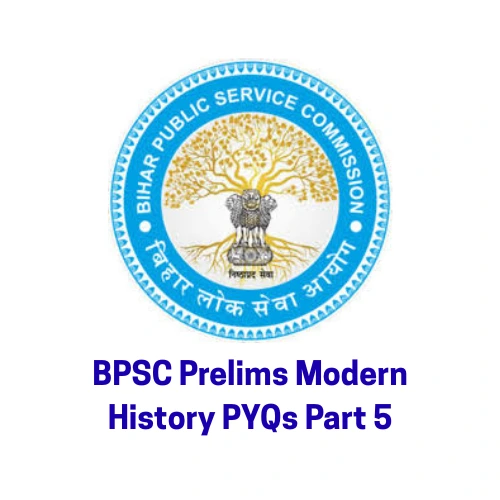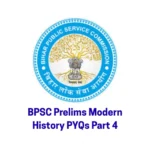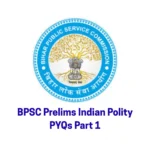In BPSC Prelims Modern History PYQs Part 5, Modern History questions span from the arrival of Europeans to India’s freedom struggle. Commonly asked areas are:
- European trading rivalries & British expansion.
- Reform movements and peasant/tribal uprisings.
- The 1857 Revolt with Kunwar Singh’s leadership in Bihar.
- Nationalist phases: Moderates, Extremists, Gandhian movements.
- Role of revolutionaries, INA, and Subhas Chandra Bose.
- Bihar’s contribution, especially Champaran Satyagraha & Quit India.
BPSC Prelims Modern History PYQs Part 5
Under whose leadership was “Suppression of Thugs” achieved?
(a) Lord Clive
(c) Lord Minto
(b) Captain Sleeman
(d) Alexander Burnes.
(e) None of the above/More than one of the above
Ans. (b)
The Viceroy who followed aggressive policy towards Afghanistan was
(a) Lord Mayo
(c) Lord Dufferin
(b) Lord Lytton
(d) Lord Canning
(e) None of the above/More than one of the above
Ans. (b)
In 1930, from where Mahatma Gandhi started the Civil Disobedience Movement?
(a) Wardha
(c) Sevaram
(b) Dandi
(d) Sabarmati
(e) None of the above/More than one of the above
Ans. (b)
The Sarabandi Campaign of 1922 was led by
(a) Chittaranjan Das
(b) Sardar Vallabhbhai Patel
(c) Rajendra Prasad
(d) Lala Lajpat Rai
(e) None of the above/More than one of the above
Ans. (b)
Who was the President of the Indian National Congress at the time of partition of India?
(a) JB Kripalani
(b) Jawaharlal Nehru
(c) Maulana Abul Kalam Azad
(d) C Rajagopalachari
(e) None of the above/More than one of the above
Ans. (a)
Modern History PYQs Questions with Answers
Which revolutionaries were hanged in the Kakori Train Robbery Case?
(a) Ram Prasad Bismil and Ashfaqulla
(b) Veer Savarkar and Vasudev Chapekar
(c) Prafulla Chandra Chaki and Khudiram Bose
(d) Surya Sen and Udham Singh
(e) None of the above/More than one of the above
Ans. (a)
Who wrote the book “India for Indians”?
(a) CR Das
(c) V D Savarkar
(b) MG Ranade
(d) S.N Banerjee
(e) None of the above/More than one of the above
Ans. (a)
Satyasodhak Samaj was founded by
(a) Dayanand Saraswati
(b) Jyotirao Phule
(c) Gandhiji
(d) Dr Baba Saheb Ambedkar.
(e) None of the above/More than one of the above
Ans. (b)
Who was the first woman President of the Indian National Congress?
(a) Kasturba Gandhi
(c) Sarojini Naidu
(b) Mrs Annie Besant
(d) Bhakti Laxmi Desai
(e) None of the above/More than one of the above
Ans. (b)
Who was the first Satyagrahi of the Individual Satyagraha Movement?
(a) Sarojini Naidu
(b) C Rajagopalachari
(c) Vinoba Bhave
(d) Subhash Chandra Bose.
(e) None of the above/More than one of the above
Ans. (c)
Who was the founder of the “India House” in London?
(a) Shyamji Krishna Varma
(b) Rash Behari Bose.
(c) Ramchandra
(d) Taraknath Das
(e) None of the above/More than one of the above
Ans. (a)
Modern History PYQs Questions with Answers
Who wrote the book, “Desher Katha”?
(a) Sakharam Ganesh Deuskar
(b) Rajendra Prasad
(c) Nivaran Chandra
(d) Murli Mohan Prasad.
(e) None of the above/More than one of the above
Ans. (a)
Who was the founder of the Indian National Congress?
(a) William Adam
(b) A.O Hume
(c) Rash Behari Bose
(d) Moti Nehru
(e) None of the above/More than one of the above
Ans. (b)
Who said, “Swaraj is my birthright and I shall have it”?
(a) Bipin Chandra Pal
(b) Aurobindo Ghosh
(c) Bal Gangadhar Tilak
(d) Subash Chandra Bose
(e) None of the above/More than one of the above
Ans. (c)
Rabindranath Tagore gave up his “knighthood” because of
(a) Brutal suppression of Civil Disobedience Movement.
(b) Execution of Bhagat Singh.
(c) Jallianwala Bagh Tragedy
(d) Chauri Chaura Incident.
(e) None of the above/More than one of the above
Ans. (c)
Who established the “Servants of India Society”?
(a) Lala Lajpat Rai
(b) Bipin Chandra Pal
(c) Gopal Krishna Gokhale
(d) Bhagat Singh.
(e) None of the above/More than one of the above
Ans. (c)
Which of the following was not a reason for making the sepoys of the East India Company rebellious?
(a) The efforts of the officers of the Company to spread Christianity.
(b) The order to the sepoys to travel on ships.
(c) The stoppage of batta.
(d) The inefficiency of the officers
(e) None of the above/More than one of the above
Ans. (d)
BPSC Prelims Modern History PYQs Part 5
Whom among the following did not rebel against the British East India company’s control over them?
(a) Raja of Vijaynagaram.
(b) Nizam of Hyderabad
(c) Polygar of Tamil Nadu
(d) Dewan Velu Thampi of Travancore
(e) None of the above/More than one of the above
Ans. (b)
The Indigo Rebellion was about
(a) The peasant not wanting to grow Indigo but being forced to.
(b) The peasant wanting to grow Indigo but being forced not to
(c) The peasant not wanting to grow Indigo but being forced to grow at price that was unacceptable.
(d) A protest movement that carried an Indigo-coloured flag.
(e) None of the above/More than one of the above
Ans. (c)
The immediate cause of the “Deccan Riots of 1875” was
(a) The shadow of a famine.
(b) High Interest rates charged by Mahajans
(c) High Land revenue rates.
(d) Protest against imposition of religious reforms.
(d) None of the above/More than one of the above
Ans. (b)
Rajni Palme Dutt said, “They both fought and collaborated with Imperialism”. Which political grouping he was referring to?
(a) The Indian National Congress
(b) The Communist Party of India
(c) The Swaraj Party
(d) Hindustan Socialist Republican Association
(e) None of the above/More than one of the above
Ans. (a)
Which of the following was not a “nationalist” newspaper?
(a) The Hindu
(c) The Mahratta
(b) Bengalee
(d) The Times of India
(e) None of the above/More than one of the above
Ans. (d)
Modern History PYQs with answers
Identify the correct combination from the options given below for Prarthana Samaj, Young India, Lokhitvadi, Satyasodhak Samaj, Rehnumai Mazdayasan Sabha.
(a) Gopal Hari Deshmukh, Atmaram Pandurang, Mohandas Karamchand Gandhi, Jyotiba Phule, Naoroji Furdonji.
(b) Atmaram Pandurang, Mohandas Karamchand Gandhi, Gopal Hari Deshmukh, Jyotiba Phule, Naoroji Furdonji.
(c) Atmaram Pandurang, Jyotiba Phule, Mohandas Karamchand Gandhi, Gopal Hari Deshmukh, Naoroji Furdonji.
(d) Naoroji Furdonji, Atmaram Pandurang, Mohandas Karamchand Gandhi, Gopal Hari Deshmukh, Jyotiba Phule.
(e) None of the above/More than one of the above
Ans. (b)
Bal Gangadhar Tilak came to be known as “Lokmanya Tilak” when
(a) He became a popular teacher
(b) He started a popular newspaper
(c) The government accused him in the Rand Murder case.
(d) He started the Shivaji and Ganpati Festivals.
(e) None of the above/More than one of the above
Ans. (c)
How old was Bhagat Singh when he threw a bomb in the assembly in protest against the government?
(a) 21 years
(b) A little more than 21 years
(c) 25 years
(d) A little more than 25 years
(e) None of the above/More than one of the above
Ans. (b)
The Jallianwala Bagh Massacre happened in the context of which Gandhian Satyagraha?
(a) Swadeshi Satyagraha
(b) Rowlatt Satyagraha
(c) Bardoli Satyagraha
(d) Individual Satyagraha
(e) None of the above/More than one of the above
Ans. (b)
BPSC Prelims Modern History PYQs Part 5
From the options given below, find the correct combination of the names of editors of the nationalist newspapers, The Hindu, Kesari, Bengalee, Hindustani, Sudharak.
(a) Surendra Nath Banerjee, G. Subramania Iyer, Bal Gangadhar Tilak, Ganga Prasad Verma, Gopal Krishna Gokhale.
(b) Bal Gangadhar Tilak, G. Subramania Iyer, Surendra Nath Banerjee, Ganga Prasad Verma, Gopal Krishna Gokhale, Surendra Nath Banerjee.
(c) G. Subramania Iyer, Bal Gangadhar Tilak, Ganga Prasad Verma, Gopal Krishna Gokhale, Surendra Nath Banerjee.
(d) G. Subramania Iyer, Bal Gangadhar Tilak, Surendra Nath Banerjee, Ganga Prasad Verma, Gopal Krishna Gokhale,
(e) None of the above/More than one of the above
Ans. (d)
So always with the assent and often to the dictates of the Chamber of Commerce, the government of India is carried on and this is the “White Man’s Burden”. Who said this?
(a) Bankim Chandra Chatterjee
(b) Mahatma Gandhi
(c) Sachchidananda Sinha
(d) Rajendra Prasad.
(e) None of the above/More than one of the above
Ans. (c)
Who began the Faraizi Movement?
(a) Haji Shariatullah
(c) Sultan Sikander
(b) Syed Ahmed
(d) MA Jinnah
(e) None of the above/More than one of the above
Ans. (a)
Who wrote the book, “Poverty and Un-British Rule in India”?
(a) R.C Dutt
(b) Dadabhai Naoroji
(c) Bipin Chandra Pal
(d) Lajpat Rai
(e) None of the above/More than one of the above
Ans. (b)
Who raised the Flag of Independence at the Congress Session of 1929?
(a) Maulana Mohammad Ali
(b) Pandit Jawaharlal Nehru
(c) Vallabhbhai Patel
(d) Subash Chandra Bose
(e) None of the above/More than one of the above
Ans. (b)
Bombay Presidency Association was established by
(a) Pherozeshah Mehta
(b) KT Telang
(c) W.C Banerjee
(d) Tayabji
(e) None of the above/More than one of the above
Ans. (e)
Modern History PYQs with answers
Who established Imperial Cadet Crops?
(a) Lord Minto
(c) Lord Lytton
(b) Lord Curzon
(d) Lord Rippon
(e) None of the above/More than one of the above
Ans. (b)
The declaration of Partition of Bengal was done on
(a) 19th July, 1905
(b) 7th August, 1905
(c) 15th August, 1905
(d) 16th October, 1905
(e) None of the above/More than one of the above
Ans. (d)
Who was given life punishment for the murder of Colonel Wyllie?
(a) Madan Lal Dhingra
(b) Udham Singh
(c) Bhagat Singh
(d) Manmathanath
(e) None of the above/More than one of the above
Ans. (a)
The post of the Indian High Commission was created by which Act?
(a) The Indian Councils Act, 1909
(b) The Government of Indian Act, 1919
(c) The Government of India Act, 1935
(d) The India Independence Act, 1947
(e) None of the above/More than one of the above
Ans. (b)
The Indian National Congress did not take part in which of the following Round Table conferences?
(a) First
(b) Second
(c) Third
(d) Participated in all.
(e) None of the above/More than one of the above
Ans. (e)
Mahatma Gandhi preside over which session of the Indian National Congress?
(a) 1922
(c) 1928
(b) 1924
(d) 1930
(e) None of the above/More than one of the above
Ans. (b)
Who was not member of the Cabinet Mission?
(a) Pethick Lawrence
(b) Wavell
(c) Stanford Cripps
(d) A.V Alexander
Ans. (b)
Who wrote the pamphlet “Now or Never”?
(a) Md. Jinnah
(b) Md. Iqbal
(c) Rahmat Ali
(d) Khafi Khan
(e) None of the above/More than one of the above
Ans. (c)
Who declared “Sati” illegal?
(a) Warren Hastings
(b) William Bentinck
(c) Cornwallis
(d) Curzon
(e) None of the above/More than one of the above
Ans. (b)


